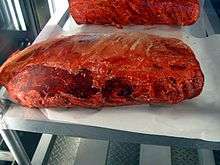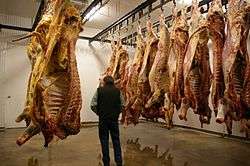Beef aging

Beef aging is a process of preparing beef for consumption, mainly by breaking down the connective tissue.
Dry-aged beef

Dry-aged beef is beef that has been hung or placed on a rack to dry for several weeks. After the animal is slaughtered and cleaned, it is hung as a full or half carcass. Primal (large distinct sections) or sub primal cuts, such as strip loins, rib eyes, and sirloin, are placed in a refrigerator unit, also known as a "hot box". This process involves considerable expense, as the beef must be stored near freezing temperatures. Subprimal cuts can be dry aged on racks either in specially climate-controlled coolers or within a moisture-permeable drybag. Moreover, only the higher grades of meat can be dry aged, as the process requires meat with a large, evenly distributed fat content. Because of this, dry-aged beef is seldom available outside of steak restaurants and upscale butcher shops or groceries. The key effect of dry aging is the concentration and saturation of the natural flavour, as well as the tenderization of the meat texture.
The process changes beef by two means. Firstly, moisture is evaporated from the muscle. The resulting process of desiccation creates a greater concentration of beef flavour and taste. Secondly, the beef's natural enzymes break down the connective tissue in the muscle, which leads to more tender beef.
The process of dry-aging usually also promotes growth of certain fungal (mold) species on the external surface of the meat. This does not cause spoilage, but actually forms an external "crust" on the meat's surface, which is trimmed off when the meat is prepared for cooking. These fungal species complement the natural enzymes in the beef by helping to tenderize and increase the flavor of the meat. The genus Thamnidium, in particular, is known to produce collagenolytic enzymes which greatly contribute to the tenderness and flavor of dry-aged meat.
Dry-aged beef is typically not sold by most supermarkets in the U.S. today, because it takes time and there is a significant loss of weight during the aging process. Dry-aging can take from 15 to 28 days, and typically up to a third or more of the weight is lost as moisture. This type of beef is served in higher-priced steakhouses and by select restaurants. Dry-aging can be done at home under refrigeration by three means: open air, with the presence of salt blocks, and with the use of a moisture permeable drybag to protect the meat while it is aging.
When dry aging using a moisture permeable material, surface mold growth is not present, flavor and scent exchange within the refrigerated environment is not a concern, and trim loss of the outer hardened surface is measurably reduced.[1] The flavor and texture profile of the beef is similar on all dimensions to the traditional open air dry-aged results.
Wet-aged beef
Wet-aged beef is beef that has typically been aged in a vacuum-sealed bag to retain its moisture. This is the dominant mode of aging beef in the U.S. and UK today. It is popular with producers, wholesalers and retailers because it takes less time: typically only a few days and there is no moisture loss, so any given piece of meat sold by weight will have a higher value than a dry aged piece where moisture loss is desired for taste at the expense of final weight. The beef is usually kept for a period of 4 to 10 days in wet aging. Modified Atmosphere Packaging (MAP) is usually employed for the vacuum packaging of meat typically between 60 and 80 per cent oxygen to retain its appetizing color, with red meat such as beef needing a higher oxygen level than less vividly colored meat such as pork.. The vacuum packed beef are stored under a temperature of 32 °F to 45 °F (0 °C to 7.2 °C).
See also
- Ham, especially country ham: pork aging, Bacon
- Hanging (meat)
References
- ↑ DeGeer, S. L.; Hunt, M. C.; Bratcher, C. L.; Crozier-Dodson, B. A.; Johnson, D. E.; Stika, J. F. (2009). "Spotlight on dry aging beef: Effects of loin type, aging methods, and aging time". Kansas State University. Agricultural Experiment Station and Cooperative Extension Service. Retrieved 2013-03-14.
Further reading
- Ahnström, M. L.; Seyfert, M.; Hunt, M. C.; Johnson, D. E. (2006). "Dry aging of beef in a bag highly permeable to water vapor". Meat Science. 73 (4): 674–679. doi:10.1016/j.meatsci.2006.03.006.
- DeGeer, S. L.; Hunt, M. C.; Bratcher, C. L.; Crozier-Dodson, B. A.; Johnson, D. E.; Stika, J. F. (2009). "Effects of dry aging of bone-in and boneless strip loins using two aging processes for two aging times". Meat Science. 83 (4): 768–774. doi:10.1016/j.meatsci.2009.08.017.
External links
- "Almost EVERYTHING You Need To Know About Dry Aged Beef!". Ask The Meatman.
- http://www.modifiedatmospherepackaging.com/applications/modified-atmosphere-packaging-fresh-meat.aspx